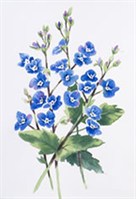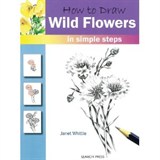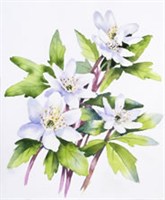
How to Draw Wild Flowers



Introduction
Wild flowers, apart from the more flamboyant species, such as poppies and bluebells, are often taken for granted as an integral part of the landscape. It's not until we look closely we see a whole world of exquisite details often missed, as, in a lot of cases, they are smaller. Drawing them can also be fraught with difficulties as they wilt and die quickly when picked and they may not be growing in a convenient place for you to sit and sketch them in peace. In this book I hope to give you a basic grounding in some of the most common species, in how to draw them, maybe for inclusion in a larger work such as a landscape, or combined with other flowers, or simply in their own right, however you choose, and whatever your style of painting.
Wild flowers, apart from the more flamboyant species, such as poppies and bluebells, are often taken for granted as an integral part of the landscape. It's not until we look closely we see a whole world of exquisite details often missed, as, in a lot of cases, they are smaller. Drawing them can also be fraught with difficulties as they wilt and die quickly when picked and they may not be growing in a convenient place for you to sit and sketch them in peace. In this book I hope to give you a basic grounding in some of the most common species, in how to draw them, maybe for inclusion in a larger work such as a landscape, or combined with other flowers, or simply in their own right, however you choose, and whatever your style of painting.
Wild flowers, apart from the more flamboyant species, such as poppies and bluebells, are often taken for granted as an integral part of the landscape. It's not until we look closely we see a whole world of exquisite details often missed, as, in a lot of cases, they are smaller. Drawing them can also be fraught with difficulties as they wilt and die quickly when picked and they may not be growing in a convenient place for you to sit and sketch them in peace. In this book I hope to give you a basic grounding in some of the most common species, in how to draw them, maybe for inclusion in a larger work such as a landscape, or combined with other flowers, or simply in their own right, however you choose, and whatever your style of painting.
The compositions are simple to start with, building up into the different shapes and angles. Using black lines for the shapes in the first step, introducing the following step in brown until the image is complete. These colours are used so you can follow the progression easily, it is better for you to use a fairly soft pencil HB, or B and not press on too heavily until you have the finish composition, then you can erase any unwanted lines.
When you are happy with the result you can shade in the tonal values using various pencils for depth, starting with a 2H or HB and up to 9B for the real darks. If you wish to then try a painting, draw the image again and apply colour instead. In the examples |I have used watercolour, but if that is not your chosen medium, use any you are familiar with including coloured pencils.
I do hope, having tried these, you will then expand the ideas by observing the flowers for yourself in the landscape as you find them, which will spark your imagination to composing a better painting. Observation is always important for artists the bonus is it is a always a rewarding and enriching experience, serving to open your eyes and become aware to how much we miss and take things for granted. Small is beautiful I promise you and in doing this book I'm am grateful to have been reminded, I hope you will be too.
Available direct from Amazon
